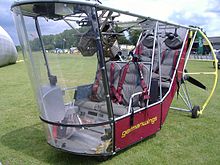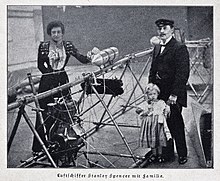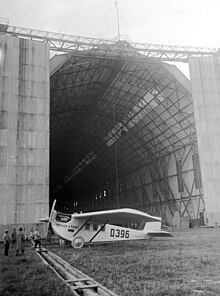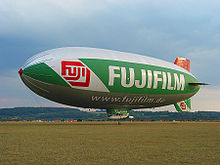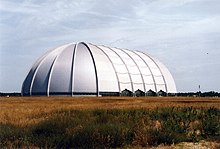Airship
An airship is a steerable aircraft whose buoyancy is based on aerostatic forces and which has its own drive unit . The main areas of application of today's airships are touristic tours, aerial advertising , surveillance and, in some cases, research tasks .
The era of airship travel began in the 19th century and peaked in the first half of the 20th century. Airships are the pioneers of civil aviation . They were the means of transport of the first airline and also the first aircraft to carry passengers across the Atlantic without stopping. The era of large airships began in World War I to meet military performance requirements. During the war, airships were used for the purpose of transporting people and goods. They were also long-range reconnaissance vehicles and the only aircraft of their time that could carry a larger load of bombs. They later protected convoys from enemy submarines and monitored the airspace.
For a long time, however, the large airship types of this time were only in a prototypical, unsafe condition, so that accidents occurred again and again. Airship technology only really came to maturity when, with the beginning of the Second World War , airships were largely displaced in the military sector, as well as in passenger and freight transport, by the rapidly developing aircraft technology .
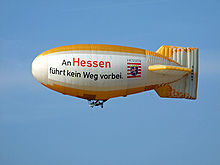
description
Layout and function
Airships consist of a mostly aerodynamically shaped buoyancy body that contains the lifting gas . Depending on the design, one or more gondolas are attached to it. In this nacelle, in some large airships also inside the float, there is space for the crew, passengers, cargo and the aggregates. Engines provide a propulsive force that is controlled with tail units .
The lifting gas gives airships their static buoyancy, as it has a lower density than air. Airships float in the air, similar to a submarine in the water. In technical jargon one speaks of driving instead of flying , see ballooning .
Today, helium is used as the carrier gas because, in contrast to the previously used hydrogen, it is not flammable. Helium is more expensive than hydrogen and about twice as heavy for the same volume, but still much lighter than air. The difference between the gas density and the air density is decisive for buoyancy. Hydrogen has about eight percent more buoyancy than helium.
Their large volume gives airships a high level of air resistance . The maximum speeds are therefore limited to around 100 to 150 km / h. Since the lifting gas expands with increasing altitude, the maximum flight altitude is usually only about 2000-3000 meters. Exceptions are the unmanned high-altitude platforms specially designed for higher air layers , which are currently being developed, and the war airships in World War I , which could climb higher than most aircraft available at the time.
Classification
In the case of airships, three basic construction methods can be distinguished:
- Impact airships , the most common design, also called blimp , are shaped by overpressure in the hull. The nacelle and tail unit are attached directly to the shell. This category also includes hot-air airships whose lifting gas, like hot-air balloons, is warm air.
- Semi-rigid airships have an additional support structure (e.g. a keel frame) on the underside of the hull, to which engines, nacelle and tail unit are attached. The envelope is held in shape by the internal pressure of the carrier gas.
- Rigid airships have an inner structure with a keel bridge and a keel passage, which defines the shape of the hull. All components are attached to this framework. Examples are the zeppelins built by Ferdinand Graf von Zeppelin .
The term hybrid airship is used for aircraft that combine lighter-than-air technology with heavier-than-air technology. The lift required is generated both aerostatically (as in conventional airships) and to a large extent aerodynamically (as in aircraft). It must be mentioned here, however, that conventional airships mostly operate “heavily”, i. H. generate a small part (about five percent) of the necessary lift aerodynamically as well.
Hybrid airships exist e.g. B. from a conventional airship body, are attached to the wings. Earlier projects for “full-fledged” hybrid airships never got beyond the prototype stage and were mostly characterized by only modest success or even failure. Currently, on January 31, 2006, the Lockheed P-791 model rose for the first time under military supervision .
In Germany, airships form a separate aircraft class under aviation law , but hot-air airships are considered to be balloons with auxiliary propulsion.
Drive and control
Gasoline aircraft engines with propellers are mainly used as drive . There have been attempts to use blue gas or the hydrogen carrier gas as fuel . Some ships also had diesel engines , but currently (as of 2005) only the ATG AT-10 has them . Diesel engines have a comparatively high degree of efficiency and the fuel has a higher energy density than gasoline . The only airship with gas turbine propulsion ( turboprop ) was the Goodyear GZ-22 " Spirit of Akron " (1987-1999).
Electric drives were used in some of the first airships in the 1880s, when powerful internal combustion engines were not yet available. Today they are gaining importance again in unmanned height platform projects or solar airships . The main problem, however, is still the poor power-to-weight ratio of the energy storage devices . A small electric airship was used to research the rainforest.
While the historical airships with hydrogen filling were able to trim their weight precisely for buoyancy by releasing lifting gas or ballast water and were thus also able to float in the air without propulsion, modern airships do not release (expensive) helium during normal operation. They are usually a little heavier than air when traveling.
In addition to the static lift caused by the lifting gas, airships use their propulsion system to generate dynamic lift . The speed and the inclination of the airship body relative to the horizontal create a lift force similar to that of an airplane with its wings . This effect is used, for example, when the airship is to rise or sink, or when the weight of the airship increases during travel due to rainwater that falls on the hull. Even when taking off, when there is still a lot of fuel on board, this effect is sometimes used in that the airship takes off with a bit of a "run-up" similar to an airplane.
Most modern airships have pivoting propellers . They make maneuvering easier and allow the ship to rise from a standing position if it is a little heavier than air and land if it is lighter than air. To do this, the pilot presses the airship with the engine power onto the ground, where it is usually immediately weighted down with some ballast and placed on the anchor mast . This way, there is no need to vent the helium.
use
Airships are distinguished from other aircraft by their ability to achieve a very long service life quietly and with low vibration with relatively low fuel consumption. You can linger over an area for hours and, if necessary, reduce the speed to a standstill.
The following main areas of application are derived from these properties:
- Air advertising : With their huge floats, airships are a real eye-catcher in the sky. As early as 1906, attempts were made to use this potential by projecting images onto the underside of the Parseval PL 6 with a projector at night , and later the covers were designed with large advertising lettering. Today, many airships carry a surface made of light elements that they use to draw graphics and text on the sky, or they can even project moving images from the inside against the transparent shell. Most of the airships are designed in color for an advertising customer or, depending on the occasion, are covered with different motifs. Surveys have shown that airships have a very high recognition value and have a positive image that is also carried over to the brands advertised. In a survey of 1046 people between the ages of 14 and 49, 90% of those questioned were aware of airship advertising and 83% rated it as positive. Only advertising on hot air balloons achieved a higher value in this regard, with approval from 88% of the survey participants.
- Sightseeing flights : As aviation pioneers , airships were the first motorized aircraft to offer the attraction of a sightseeing tour since the beginning of the 20th century. Their smooth flight allows non-flyers to view the earth from above. Their low speed and low altitude make them a good means for sightseeing flights. On many airships, the windows can also be opened.
- Monitoring (e.g. major events, traffic, military, relay station), forest fire monitoring and fighting.
- Research tasks, geological exploration, mine search.
- Switching of radio services (example Sanswire Stratellite )
In addition to these actual use purposes projects and concepts emerged in the history of aeronautics to repeatedly airships for the sole transport of freight as transport airships use. One of the best-known projects of this type is the German company CargoLifter , which wanted to develop a transport airship for cargo weighing up to 160 t, but never got beyond the conception phase. The aerospace company Boeing also worked on such a project until 2011, but also discontinued it. The British company Hybrid Air Vehicles is currently trying to develop a hybrid airship with a capacity of up to 50 t of freight and deliver it by 2015. [outdated]
history
Idea and initial developments
As early as 1670, the Italian Jesuit priest Francesco Lana Terzi had the idea of building an “airship”. He wanted to hang a boat on evacuated spheres. The idea was never realized, but was taken up by Philipp Lohmeier in 1676 in his dissertation De artificio navigandi per aërem ( From the art of sailing through the air ).
An airship draft by Jean-Baptiste Meusnier dates from 1785 , which already contained all elements such as a float with an elongated gondola suspended underneath, a rudder and three muscle-powered propellers for propulsion. However, it was not built.
In 1812 Franz Leppich failed in his attempt to move the airship he had designed for Tsar Alexander I by means of two large oars, each of which had five wing-like blades.
The first real airship, the "Giffard I", made its maiden voyage on September 24, 1852, around 50 years before the first powered flight of a fixed-wing aircraft. It was built by Henri Giffard and was powered by a 2.2 kW (3 HP) steam engine that weighed only 45 kg. The journey led from Paris to Trappes over a distance of 27 km. The speed was about 9 km / h and the flight altitude up to 1800 m. The long balloon in which Giffard had installed his steam engine was 44 m long and had a volume of 2,500 m³. The gondola and engine were suspended from a beam under the balloon. It was steered with a triangular sail. In 1855 Giffard wanted to test a second airship, but this was destroyed.
Fifteen years later, in 1872, the German engineer Paul Haenlein reached a speed of 18 km / h with his 50 m long airship “ Aeolus ”. It was powered by a Lenoir gas engine.

Only a further 12 years later, on August 9, 1884, was it possible to return to the starting point in an airship after take-off. The trip took 23 minutes. They covered a distance of 7.6 km at a height of up to 300 m. The airship La France , built from 1879 under the captains of the French airship school Charles Renard and Arthur C. Krebs (1850-1935), carried out several trips as an electric airship with battery operation . An electric motor with an output of 6.25 kW (8.5 PS) served as the drive . The La France was 50.42 m long and had a volume of 1864 m³. During the journeys they reached a top speed of 6.2 m / s (22.32 km / h).
The Russian space pioneer Konstantin Eduardowitsch Ziolkowski directed his considerations in 1885, among other things, to all-metal airships . Just one year later he published his study "Theoria Aerostatika", which was followed in 1892 by the "Aerostat Metallitscheski" (theory of an all-metal airship). By his death in 1935 he published 35 books, articles and writings on airship issues.
In Germany, the Leipzig bookseller Dr. Friedrich Hermann Wölfert continued the work of Georg Baumgarten and constructed a steering balloon. It was supposed to be steered with muscle power , but this turned out to be impractical. With the help of Gottlieb Daimler , the vehicle was instead equipped with an internal combustion engine , the so-called “ grandfather clock ”, with 1.5 kW (2 hp). On August 10, 1888, Michael, Wölfert's long-time companion, set off from Daimler's test workshop on the Seelberg in Cannstatt on a trip to Aldingen . Wölfert was later killed during a demonstration run for the Prussian airship department when his airship Deutschland crashed on June 12, 1897 in Tempelhof near Berlin from a height of 600 m.
The first rigid airship was developed by David Schwarz in Berlin in 1895/1896 . It consisted of an aluminum frame and was also planked with sheet aluminum, a new material that was only available for a short time at the time. Schwarz died before the first test drive. This took place on November 3, 1897 on the Tempelhofer Feld in Berlin. The vehicle was irreparably damaged on landing and then scrapped. The Württemberg cavalry officer Ferdinand von Zeppelin was an eyewitness at the time, bought the patents and designs and in 1898 had a design for a “steerable aerial vehicle” patented.
Beginning of the 20th century
France
In 1884 Charles Renard and Arthur H. C. Krebs completed their airship “ La France ” in Chalais-Meudon . It was the first aircraft ever that was able to return to its starting point on its own, making it the first real airship. It was built in Hangar Y, which is the oldest airship hangar that still exists today.
Around the turn of the 19th to the 20th century, the native Brazilian Alberto Santos-Dumont built a number of impact airships in France. In 1894 he used the gasoline engine of his tricycle for an airship. Four years later, in 1898, he built a total of 12 airships in a relatively short time. With the third, he circled the Eiffel Tower in Paris for the first time on November 13, 1899 . With his sixth airship and a good 11 kilometer flight from St. Cloud near Paris to the Eiffel Tower and back in no more than 30 minutes, he won the German Prize, endowed with 100,000 francs , in 1901 . In 1901 he was named Man of the Year in the World. Especially with his ninth airship, he caused a sensation in Paris and around the world. He often used this airship for excursions and visits to friends. Often he only tied his airship to a tree or in front of his hotel room.
In 1903 the ship of the Lebaudy brothers rose for the first time in France. It had a 35-horsepower Daimler-Mercedes engine that powered two propellers. The ship was further improved on several trips, including one with 2 hours and 46 minutes. These activities continued in the following years, with the ship being rebuilt several times after crash landings in trees.
Adolphe Clément built the first of his at least six airships (Clément-Bayard) in 1908 in Trosly-Breuil near Compiègne. “Clément-Bayard” N ° 1 broke the record for a closed sightseeing flight in 1908, and “Clément-Bayard” N ° 2 was the first to cross the English Channel on October 16, 1910 after taking off from Compiègne .
The airship Ville de Bordeaux was exhibited at the first aviation exhibition in the Grand Palais in Paris .
France also built military airships such as the République . In the following years, the focus of airship development shifted from France to Germany.
Germany

The most famous figure in airship travel was and is the German airship pioneer Ferdinand Graf von Zeppelin . Zeppelin's first airship, the LZ 1 , made its maiden voyage on July 2, 1900 on Lake Constance. The crash of the "Zeppelin LZ 4" near Echterdingen on August 5, 1908 led to the largest voluntary donation campaign in the German Empire, the " Zeppelin donation of the German people ".
He then built Germany's largest airship hangar in Potsdam West in 1912 with the aim of building a European aviation center. But production stopped a few years later, and in 1920 the airship hangar had to be dismantled due to the Versailles Treaty . Zeppelin also established aluminum as a material in aviation.
The first passenger air port in Germany was built in Baden-Oos in 1910 . It was built on an area of about 160 × 30 meters and was 30 meters high. On August 21, 1910 the first airship, LZ 6 , arrived in Baden-Baden . Two days later, on August 23, the first official passenger trip took place in Germany. Twelve people took part in the two-hour journey and paid 200 marks per person. The tours continued daily. However, on September 14th the airship was completely destroyed by an accident. In the same year, flight connections from Baden-Baden were offered with the LZ 7 .
When naming the Zeppelin airships, the male gender was traditionally used. It was called the LZ 127 "Graf Zeppelin" and the LZ 129 "Hindenburg". After the end of German airship travel, or its disappearance from the public interest after the Second World War, this language regulation was partially lost.
Also August von Parseval was highly popular airship pioneer in Germany after the turn of the century. Between 1909 and 1919 a total of 22 airships were built under the name Parseval , whose popularity was very high, but was still outshone by the zeppelin enthusiasm. Some of them were sold abroad.
Furthermore, were before the First World War by Major Hans Gross and chief engineer Nikolaus Basenach (1875-1951) of in Berlin-Reinickendorf on the site of today's Berlin-Tegel Airport stationed airship battalion semi-rigid military airships of bears their type wholesale Basenach built and tested.
The history of aviation fairs in Germany began with the International Aviation Exhibition from July 10th to October 17th, 1909 in Frankfurt am Main. In addition to Zeppelin, Parseval and Hermann Ruthenberg , the Cologne balloon manufacturer Franz Clouth also demonstrated his small impact airship, which could carry four passengers in addition to the helmsman and machinists. The maiden flight of the "Clouth I" took place in 1908 over Nippes . On June 21, 1910 it also drove over 200 km to Brussels for the International Industrial Exhibition. It covered around 2000 km in over 40 trips.
From 1908 Germany, like France and Belgium, carried out successful tests with radio equipment in airships. Proof was provided that the radio system posed no danger to the airship.
Furthermore, the airship " Erbslöh " made several trips around Leichlingen (Rhineland) from 1909 before it crashed on July 13, 1910.
On January 23, 1911, the Siemens-Schuckert airship (SSL1) took off for its first test drive from the airship hangar in Biesdorf-Süd (today in Berlin) .
Great Britain
The first English airship was Stanley Spencer 's " Mellin's Food Airship " . The first flight took place in 1902 over London. Stanley's "No. 2 ”made its maiden voyage in September 1903 over the London Crystal Palace .
United States
Walter Wellman (1858–1934) from the USA started in 1906, 1907 and 1909 for the first time in a dirigible airship towards the North Pole . However, all three attempts failed. On October 15, 1910, he tried to cross the Atlantic with the airship "America". This attempt also failed in the ocean 1,600 km from the coast. On this occasion, he used his emergency call for the first time to send a radio message from an aircraft to a sea craft . This saying was: "Roy, come and get 'the goddamn cat!" Thus the "Kiddo" cat was meant to be a stowaway had smuggled on board.
Spain
Leonardo Torres Quevedo built his first semi-rigid airship España in 1905 , which made successful voyages. Then began the cooperation between Torres and the French company Astra , which began in 1911 with the construction of the Astra-Torres airships , some of which were sold to the French and British armed forces from 1913 and used in the First World War.
Russia
Five airships had been built by 1914. Among them was the 1912 built in the company DEKA SA Nemchenko airship Kobchik .
First World War
The outbreak of the World War in 1914 brought about great technical progress . However, during the war, only Germany made extensive use of military airships in the army and in the navy for air warfare over land and sea. All other nations used their air cruisers mainly in the navy . During the war, a total of around 300 non-rigid and around 100 rigid airships were used.
The United States had in the period 1919 to 1933 a total of 31 blimps and a semi-rigid airship for the Army in the service, after which all ships were sent to the Navy issued. Italy's 18 army ships fought almost exclusively in the navy. The British also incorporated their six impact airships assigned to the army into the navy when war broke out. The non-rigid airships worked successfully primarily for surveillance of the sea and as an escort for merchant ship convoys. Then there were the rigid airships from Zeppelin and Schütte-Lanz and the English models, which were mainly used as reconnaissance aircraft and bombers.
Zeppelin and Schütte-Lanz
Ferdinand Graf von Zeppelin drove the development of the rigid airships , which are therefore often called "Zeppelins" after him. By using a rigid skeleton, much larger airships could be built that could carry a larger payload and had a larger operating radius.
Luftschiffbau Zeppelin GmbH's biggest competition in Germany was Luftschiffbau Schütte-Lanz in Brühl near Mannheim , founded in 1909 by Johann Schütte and Karl Lanz . The first ship "SL-I" rose in 1911. However, this airship did not prove itself. With the "SL-II", which is referred to as the standard airship of the First World War, Schütte succeeded in creating a technical lead over the Zeppelin airships, but the "Schütte-Lanz System" never celebrated Zeppelin's successes. Schütte-Lanz only supplied the German military . In contrast to the zeppelins, all SL airships had a frame made of plywood . After the First World War, almost all of the airship hangars in the German Reich had to be demolished or delivered as reparations due to the Treaty of Versailles . Only a building hall at the Zeppelin shipyard in Friedrichshafen and a hall in the airship port Seddin near Stolp remained. That (among other things) meant the end for Schütte-Lanz as an airship builder. Only the plywood construction remained and is now operated by the Finnish company Finnforest.
The heyday between the world wars
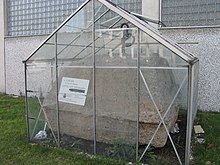
Between the two world wars, the developed transport airships . Even before the war there had been efforts to offer regular trips between different European cities. The world's first airline was founded for this purpose in 1909 . The DELAG (Deutsche Luftschiffahrts Aktiengesellschaft) operated Zeppelin airships in the transport service. You and other airshipmen who wanted to operate civil projects in Germany, however, were thwarted by the Allies and the Versailles Treaty . During the war, the German airships in particular had developed into high-tech carriers. However, German post-war airships were banned, and all large war and even some post-war airships had to be surrendered as reparations . In other European countries the potential and the feasibility of airships were investigated.
The first Atlantic crossing was made from July 2 to 13, 1919 by the British airship R34 with Major Scott and a crew of 31, an extensive copy of a German zeppelin. The airship needed 108 hours for the non-stop flight across the Atlantic from Scotland to New York and only 75 hours for the return trip, as the tail wind ( westerly wind zone ) was used.
The builders of the Empire State Building (ESB) wanted to address the problem of large open spaces for airship landings by installing an anchor mast on the roof of what was then the most modern high-rise in the world . However, there was never an airship landing there: Soon so many other high-rise buildings were built in Manhattan that even using helium airships was no longer an option. Today you can see the 7 wonders of the world on the 4 walls in the Luxor- style vestibule of the ESB and - as the 8th wonder of the world - the ESB itself, just like an airship is docking at it.
The US ZR-1 USS Shenandoah was the first large airship to be filled with helium in 1923 . Although it was designed for hydrogen as a carrier gas, after several successive accidents with other airships it was decided to use the expensive but non-flammable helium that was then only available in limited quantities in the USA.
In 1926 Umberto Nobile crossed the North Pole in the airship “ Norge ” with Roald Amundsen on board . They won the race for the first North Pole crossing in the air against the American Richard Byrd , who falsely claimed this first crossing in the air for himself only three days earlier.
The Zeppelin LZ 126 / ZR-3 "USS Los Angeles" , built for the USA as a reparation payment , was the first airship to land and take up an aircraft in the air in 1929. The USS Akron , jointly developed by Goodyear and Zeppelin, entered service for the US Navy in 1931. In size it corresponded roughly to the later LZ 129 "Hindenburg", but it was used for long-range military reconnaissance over the sea. In this, she was supported by airplanes that could be launched from the airship and caught again during the journey. The USS Akron was lost in a storm over the Atlantic in April 1933. Over 70 crew members were killed. Her sister ship, the USS Macon , entered service in 1933. It was lost in February 1935 off the coast of California after a tail breakage. Two crew members died in the process.
ZMC-2 was an all-metal airship built in 1929. The shell was made of riveted duralumin sheet metal . The construction was self-supporting. However, despite the innovative and promising concept, there was only one prototype . The ship was disarmed after the planned 10-year service life and trouble-free operation in the US Navy .
The two British airships R100 and R101 were only slightly smaller than the later LZ 129 “Hindenburg” . Both were built around 1930 and, as passenger airships, were intended to improve connections within the British Empire. R100 has made several successful trips, including one to Canada. R101 had been completed a little earlier, but proved to be insufficiently stable and was extended. After further changes and very few test drives, the ship set out on its maiden voyage to Karachi in October 1930 . Already near the French city of Beauvais , the ship hit the ground in bad weather and caught fire. 48 people were killed. After extensive parliamentary debate, the R100 was scrapped at the end of 1931.
Few and difficult to test facts are known about airship travel in Russia and the Soviet Union. The Russian airship " USSR-W6 Ossoawiachim " (CCCP-B6) , built under the guidance of Umberto Nobile, carried out its maiden voyage on November 5, 1934. It is considered the most successful airship in the Russian airship industry .
In 1924, the Zeppelin captain Hugo Eckener was the first German Atlantic aviator who flew the route from Friedrichshafen to Lakehurst in three days and three hours with a crew of 30 and Hugo Eckener became so popular in Germany that he was a serious candidate against Adolf in the 1932 presidential election Hitler was being considered. The largest airships of all were the Zeppelins LZ 129 built in 1931 in Friedrichshafen for the first time on March 4, 1936 and the construction costs of 5 million RM were the LZ 129 "Hindenburg" and its sister ship LZ 130 Graf Zeppelin II with a length of 245 meters and a hull diameter of over 40 meters and a capacity of around 200,000 cubic meters of hydrogen lifting gas. The "Hindenburg" could carry 50-70 passengers over a distance of 17,500 kilometers. On May 6, 1937, however, it went up in flames when it landed in Lakehurst / USA , killing 36 people. This disaster was not the worst in airship travel , but the “Hindenburg disaster” went down in history as one of the great technical disasters (also due to Herbert Morrison's emotional radio report , which became world famous). It was also the final rigid airship accident . The looming Second World War ended the era of rigid airship travel.
Since then , commercial aircraft - the technology of which made great advances in the 1930s and 1940s - have dominated air traffic .
The second World War
During the Second World War , military airships were used very successfully by the Allies as coastal patrols, maritime patrols and for guarding convoys against enemy (mostly German) submarines at sea in large numbers. More than 100 airships served in the US Navy, including on the US coast, in Europe and in the Pacific.
After 1945
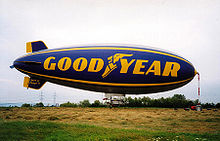
After the end of the war with the emergence of the Cold War , the airships continued to serve primarily in the US military. It used impact airships for strategic and tactical radar sea and air surveillance and for submarine hunting until the 1960s . However, the development of more powerful helicopters and long-haul aircraft led to their replacement.
Since then, impact airships have been used primarily as advertising media, for example at major events and for tours. The Goodyear airships became particularly well known . In the 1970s the first modern airships were created by WDL Luftschiffgesellschaft in Germany or Westinghouse Airship in Great Britain , later by the Lightship Group (1980s) and Eros Corporation (1990s), both in the USA .
In the 1970s, the first hot air airships , derived from hot air balloons , were built. They are mainly used as advertising media, are relatively small, but can also be transported with a vehicle without any problems and require practically no infrastructure. Your balloon envelope can be folded up; Since they do not contain any special lifting gas, but only derive their buoyancy from the difference in density between warm and cold air, they can be built up and dismantled without financial losses by releasing the gas. However, similar to balloons, they are pure fair-weather aircraft.
Small remote-controlled unmanned airships serve as advertising media, for example at exhibitions inside and outside of buildings, while larger unmanned ships are used for aerial photography , for example . They also offer the option of carrying other sensors.
It was not until the turn of the millennium, at which time there were around 30 operational airships, that larger airship projects were tackled again:
The German company Cargolifter AG was founded with the aim of revolutionizing heavy load transports by multiplying the maximum payload and eliminating transport and, indirectly, constructional restrictions of large industrial plants. Heavy road transports in this country are tied to a maximum weight of a little over 40 tons and the specified road width and length to the existing curve radii.
For loads of up to 160 tons, a cargo airship was to be built at the end of the 1990s : the CL160 .
For this purpose, the company built the largest self-supporting hall in the world as an airship shipyard in Brandenburg, in the municipality of Halbe . After work on the CL160 airship began, the company ran out of money in the meantime. The reviews and speculations indicated that investors and customers apparently no longer had enough confidence in the technical and economic feasibility of the project. Finally, Cargolifter AG had to file for bankruptcy at the beginning of June 2002. The project remained unfinished, the shipyard was converted into the Tropical Islands leisure park in 2004 .
Since 2000 the Zeppelin NT of the ZLT Zeppelin Luftschifftechnik GmbH & Co KG has been regularly transporting tourists across Lake Constance and other places. The Zeppelin NT 07 has been the largest active airship in the world since its maiden voyage. Several airships of the type were built and deployed around the world. After giving up its own production, Goodyear is converting its airship fleet to Zeppelin NT.
From October to November 2000, a TLG A60 + airship helped the UN search for mines and duds in Kosovo . A radar device was used.
In recent years, airships have also been rediscovered as a platform for surveillance tasks, especially at major events.
present
In 2006 there were three companies in Germany that built and operated airships:
- GEFA FLIGHT in Aachen (hot air airships)
- WDL Luftschiffgesellschaft at Essen / Mülheim Airport (impact airships )
- Luftschiffbau Zeppelin GmbH in Friedrichshafen (semi-rigid airships)
There are also a few projects that are currently only available in studies.
Skycruise Switzerland has been running airship tours in Buochs, Switzerland , since 2002 . According to the FOCA, eight hot-air airships in addition to the Skycruise airship were approved in Switzerland in September 2005 . In mid-2006, the Skycruise airship received an American license again and left the country. No (gas) airships are permitted in Austria.
In addition to the German models, there are a number of other impact and hot air airships, mainly of English and American origin, in use worldwide (e.g. ABC , Eros , Goodyear , SkyShip , TLG ). Unmanned airship travel is also gaining in importance. In addition to projects for high-altitude platforms , the unmanned use of airships for civil and military surveillance tasks is also examined and tested.
In Russia, some impact and hot air ships have also been developed and built by Augur Luftfahrtsysteme . The first airships developed in China were approved at the end of 2004 and come from the Huajiao company .
| 1986-89 | 1990-92 | 1993-94 | 1995-2000 | 2001-2002 | 2003-2004 | 2005-2008 | 2009 | 2010 | 2011 | 2012 | 2013 | 2014 | 2015 | 2016-18 |
|---|---|---|---|---|---|---|---|---|---|---|---|---|---|---|
| 2 | 3 | 2 | 3 | 5 | 6th | 4th | 3 | 4th | 3 | 5 | 3 | 3 | 3 | 3 |
Projects
- The prototype Piasecki Heli-Stat was an attempt in the 1980s to combine airship and helicopter into one means of transport.
- Lockheed Martin P-791 - the prototype (registration number N791LM) was first tested on January 31, 2006 in Palmdale, California on a five-minute flight. The manned four-engine airship has an estimated length of around 60 m and has air cushions as a landing gear. It is a "hybrid airship" that is supposed to use static and dynamic lift. The shape resembles three adjoining airship hulls.
- Various companies tried and are trying to revive tourism with airships beyond short sightseeing flights. However, there was still no practical undertaking. Above all, there is a lack of large airships that allow profitable operation.
- The German LoftyCruiser GmbH & Co. KG is investigating the technical feasibility of a large cruise airship .
- The Zeppelin Tourism Association V. has developed a concept for European airship traffic with Zeppelin Europe Tours .
-
Elevation platform - unmanned solar powered airships are to be used as communication platforms similar to satellites .
- With the Stratellite , a prototype is currently being built in the USA (2005).
- Another project is Aerosphere , a spherical or ball-shaped airship concept that is also to be used as a high-altitude platform.
- In the USA there are considerations to ascend to an altitude of up to 50 km with an airship and then to get into orbit by means of an ion drive . However, it has not yet been technically implemented.
- The Dynalifter is a hybrid model that combines helium lift with lift from aerofoils. It is primarily intended to be used to transport cargo and people in regions of Africa that are difficult to access. The airship is heavier than air, which makes landing easier. In March 2011, successful test flights were reported in a press release.
- 2010: The TU Berlin develops and builds a hot air ship as part of the IsoLuftschiff project workshop, which is characterized by a multilayered, insulated shell. This special cover increases the effectiveness of the airships in terms of flight time and speed compared to conventional materials. A radio-controlled, 15-meter long prototype is specifically planned. Experience from building remote-controlled helium airships on a smaller scale is incorporated here.
- 2013: The 77-meter-long airship prototype Dragon Dream from Worldwide Eros was successfully tested in the USA . Two larger variants are planned. One version should be able to transport 66 tons of cargo, the other 250 tons. In December 2013, the airline Cargolux signed a letter of intent to acquire Eros airships.
- NASA and the Keck Institute conducted a study to research the possibilities of using airships as long-term suborbital astronomical research platforms.
Others
- From the beginning of the balloon flight until well into the 19th century, balloonists were consistently referred to as "airshipmen".
- The aeronautical greeting is "Glück ab!" , Cf. in mining “ Glück auf! "
See also
Movies
- The stolen airship , 1966
literature
- Henry Beaubois, Carlo Demand (drawings): Airships: An Illustrated History. (Original French title: Dirigeables translated and edited by Michael Kelly and Angela Kelly) Macdonald and Jane's, London 1973, ISBN 0-356-08103-6 (English).
- Jürgen K. Bock, Berthold Knauer (Ed.): Lighter than air. Transport and carrier systems. Balloons, airships, platforms. Frankenschwelle, Hildburghausen 2003, ISBN 3-86180-139-6 .
- Helmut Braun: The rise and fall of airship travel - an economic historical analysis. eurotrans-Verlag, Regensburg 2007, ISBN 3-936400-22-9 .
- Dietrich Engberding: Airship and airship travel in the past, present and future. VDI-Verlag, Berlin 1928 (2nd, expanded edition).
- Dorothea Haaland, Hans Georg Knäusel, Günter Schmitt, Jürgen Seifert: Lighter than air - balloons and airships. Bernard & Graefe, Bonn 1997, ISBN 3-7637-6114-4 .
- Guy Hartcup: The Achievement of the Airship: A History of the Development of Rigid, Semi-Rigid, and Non-Rigid Airships. David and Charles, London 1974, ISBN 0-7153-6551-7 (English).
- Hallmann, W. (2002): Balloons and airships through the ages, Königswinter.
- Gabriel A. Khoury, J. David Gillett: Airship Technology. Cambridge University Press , Cambridge UK 2004, ISBN 978-0-521-60753-7 (English).
- Lord Ventry and Eugene M. Kolesnik: Airship Saga: The History of Airships Seen Through the Eyes of the Men Who Designed, Built and Flew Them. Blandford Press, Poole 1982, ISBN 0-7137-1001-2 (English).
Web links
- Pilot and airship
- Airship Index (English)
- Luftschiffharry.de - Working group on naval and army airship and seaplane history
- The airships of the Zeppelin type
- Luftschiffseiten.de
- The recent history of airship construction - an article by Dr.-Ing. P. Schuster from the 1920s
- Loftycruiser GmbH & Co. KG - German study of a cruise airship project
- earlyaviator.com - Collection of images of early airships
- The history of the airships - a brief outline from the first unmanned hot air balloon to the modern airship.
Individual evidence
- ↑ Exploration of the rain forest canopy using airships and other methods. (No longer available online.) Dendronautics.org, archived from the original on June 14, 2006 ; accessed on May 8, 2010 (English).
- ↑ Report on the operations of D4 (English) PDF file 84 kB
- ↑ It Works: The It Works Ambient Media Study. An intermedia reach study on 65 out of home media with a focus on ambient compared to classic outdoor and transport advertising , Düsseldorf, January 2004
- ↑ The West: New Zeppelins for Pipeline Construction in Canada
- ↑ Helmut Braun: The rise and fall of airship travel - an economic historical analysis. eurotrans-Verlag, Regensburg 2007, ISBN 3-936400-22-9 .
- ↑ Patent CH16343 : Air vehicle, the traction body of which is provided with separately arranged motors. Registered on January 3, 1898 , published on November 15, 1898 , inventor: Ferdinand, Graf von Zeppelin.
- ^ The First Paris Aeronautical Salon in Flight, January 2, 1909 issue
- ^ The first passenger airport in Germany was built in Baden-Baden - article on the Baden-Baden website
- ^ Flight edition of January 2, 1909, p. 5
- ^ Allan Janus: Animals Aloft: Photographs from the Smithsonian National Air and Space Museum . Bunker Hill Publishing, Inc., 2005, ISBN 978-1-59373-048-2 , p. 28.
- ^ Konstantynowicz Bogdan: Brief genealogy of the noble Konstantinavičius / Konstantinovich ancestry from Belarus and Lithuania. Retrieved May 26, 2019 .
- ↑ Annual report of the Federal Aviation Office 2003/2004; Page 41 for airships from 1986–2003; accessed online as PDF on December 30, 2016
- ↑ Annual report of the Federal Aviation Office 2014/2015/2016; Page 44 (license plate class L: airships 1992–2015); accessed online as PDF on December 30, 2016
- ↑ https://www.lba.de/SharedDocs/Downloads/DE/SBl/SBl3/Publikationen/jahresberichte/Bericht_2017_2019.html?nn=2142284
- ↑ Skunk Works' new craft over Plant 42 - Press release from Antelope Valley Press dated February 5, 2006.
- ↑ Picture of the Lockheed Martin P-791 aircraft. airliners.net, accessed May 8, 2010 .
- ↑ Dynalifter's Historic First Steps to Flight ( Memento from January 20, 2012 in the Internet Archive )
- ↑ Isoluftschiff. isoluftschiff.de, accessed on June 25, 2010 .
- ↑ Airship is supposed to revolutionize freight transport. ( Welt Online , September 12, 2013)
- ↑ New start for giant cargo zeppelins in Europe . In: Die Welt , December 14, 2013. Retrieved December 14, 2013.
- ↑ Modern Research Borne on a Relic nytimes.com; AIRSHIPS- A New Horizon for Science kiss.caltech.edu, pdf, accessed on February 15, 2016

